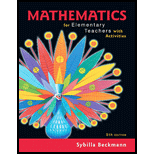
Concept explainers
Suppose that 1% of the population has a certain disease. Also suppose that there is a test for the disease, but it is not completely accurate: It has a 2% rate of false positives and a 1 % rate of false negatives. This means that the test reports that 2% of the people who don’t have the disease do have it, and the test reports that 1% of the people who do have the disease don’t have it. This problem is about the following question:
If a person tests positive for the disease, what is the probability that he or she actually has the disease?
Before you start answering the next set of questions, go back and read the beginning of the problem again. Notice that there is a difference between actually having the disease and testing positive for the disease, and there is a difference between not having the disease and testing negative for it.
a. What do you think the answer to the previous question is? (Answer without performing any calculations—just make a guess.)
b. For parts (b) through (f), suppose there is a random group of 10,000 people and all of them are tested for the disease.
Of the 10,000 people, ¡n the ideal, how many would you expect to actually have the disease and how many would you expect not to have the disease?
c. Continuing part (b), of the people from the group of 10,000 who do not have the disease, how many would you expect to test positive, in the ideal? (Give a number, not a percentage.)
d. Continuing part (b), of the people from the group of 10,000 who have the disease, how many would you expect to test positive? (Give a number, not a percentage.)
e. Using your work in parts (c) and (d), of the people from the group of 10,000, how many in total would you expect to test positive, in the ideal?
f. Using your previous work, what percent of the people who test positive for the disease should actually have the disease, in the ideal? How does this compare to your guess in part (a)? Are you surprised at the actual answer?
Want to see the full answer?
Check out a sample textbook solution
Chapter 16 Solutions
Mathematics for Elementary Teachers with Activities Plus MyLab Math -- Title-Specific Access Card Package (5th Edition)
- Already got wrong chatgpt answer Plz don't use chatgpt answer will upvotearrow_forwardFind all values of x for the given function where the tangent line is horizontal. 3 =√x³-12x² + 45x+5arrow_forwardFind the equation of the tangent line to the graph of the given function at the given value of x. 6 f(x) = x(x² - 4x+5)*; x=2arrow_forward
- 7. Suppose that X is a set, that I is a nonempty set, and that for each i Є I that Yi is a set. Suppose that I is a nonempty set. Prove the following:2 (a) If Y; CX for all i EI, then Uiel Yi C X. ¹See Table 4.8.1 in zyBooks. Recall: Nie X₁ = Vi Є I (x = X₁) and x = Uier X₁ = i Є I (x Є Xi). (b) If XCY; for all i Є I, then X Ciel Yi. (c) U(x)=xnUY. iЄI ΕΙarrow_forwardFind the equation of the tangent line to the graph of the given function at the given value of x. f(x)=√√x+33; x=4arrow_forwardFind g[f(-7)]. f(x) = x² + 1; g(x)=-5x-1arrow_forward
- Find the x-values where the following do not have derivatives.arrow_forward8. For each of the following functions, determine whether or not it is (i) injective and/or (ii) surjective. Justify why or why not. (a) fiZZ defined by fi(n) = 2n. (b) f2 RR defined by f2(x) = x² − 4x+7. : (c) f3 Z {0, 1} defined by f3(n) = 0 if n is even and f3(n) = 1 if n is odd. (d) f4 Z N defined by f4(n) = 2n if n > 0 and f4(n) = -2n-1 if n < 0.arrow_forward2. Disprove the following by finding counterexamples: 3. (a) For all sets A and B, AU (BNA) = B. (b) For all sets A, B, and C, ANBCC if and only if ACC and B C C. Suppose A and B are subsets of a universal set U. Using the set identities¹ prove the following: (a) (ANB) U(ANB) = B (b) A (BA) = Aarrow_forward
 Holt Mcdougal Larson Pre-algebra: Student Edition...AlgebraISBN:9780547587776Author:HOLT MCDOUGALPublisher:HOLT MCDOUGAL
Holt Mcdougal Larson Pre-algebra: Student Edition...AlgebraISBN:9780547587776Author:HOLT MCDOUGALPublisher:HOLT MCDOUGAL Big Ideas Math A Bridge To Success Algebra 1: Stu...AlgebraISBN:9781680331141Author:HOUGHTON MIFFLIN HARCOURTPublisher:Houghton Mifflin Harcourt
Big Ideas Math A Bridge To Success Algebra 1: Stu...AlgebraISBN:9781680331141Author:HOUGHTON MIFFLIN HARCOURTPublisher:Houghton Mifflin Harcourt Glencoe Algebra 1, Student Edition, 9780079039897...AlgebraISBN:9780079039897Author:CarterPublisher:McGraw Hill
Glencoe Algebra 1, Student Edition, 9780079039897...AlgebraISBN:9780079039897Author:CarterPublisher:McGraw Hill- Algebra & Trigonometry with Analytic GeometryAlgebraISBN:9781133382119Author:SwokowskiPublisher:Cengage



